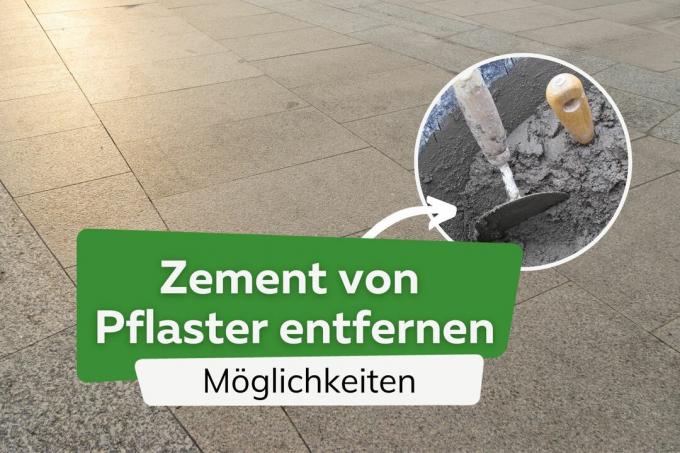
When grouting a paved surface or various construction projects on your own property, concrete or cement residues are not uncommon. Various methods are available to remove cement from pavement.
In a nutshell
- Remove residue immediately
- Note stone type
- wash off thoroughly
- Ideally prevent stains
Table of contents
- Wipe off wet cement residue
- high pressure cleaner
- hammer and chisel
- Cement Haze Special Remover
- Vinegar
- washing soda
- rock oil
- frequently asked Questions
Wipe off wet cement residue
Remove cement and concrete residue from the pavement as soon as possible. When wet, stains are much easier to remove, since the materials can only be worked on with a great deal of effort once they have hardened. Even larger amounts of cement or concrete can be easily removed as long as they have not yet hardened.
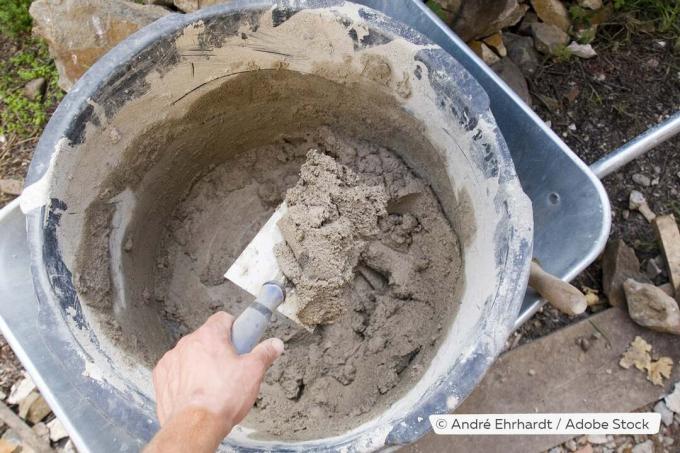
Utensils needed
- soft brush (natural stones)
- wire brush (concrete pavers)
- bucket or wheelbarrow
The bucket is needed to transport and store the wet concrete. Alternatively, you can use the bucket for water if you don't want to have the garden hose on all the time or if there is no water source in the immediate vicinity. The following steps detail the working process.
Instructions
- Dispose of larger concrete residues directly
- Soak leftovers on cobblestones with water
- brush thoroughly
- then rinse off
- repeat as needed

A notice: You can effectively collect the resulting concrete water in a hole in the ground and then dispose of it. Cover the hole with a tear-resistant tarpaulin or a sturdy garbage bag so that the concrete water does not get into the ground.
high pressure cleaner
The pressure washer is also excellent for removing concrete residue, even if it has already hardened. However, the devices achieve the best results when the cement is not completely dry. The material of the stone is also important. Only the following paving stones are suitable:
- concrete
- quartzite
- granite
- basalt
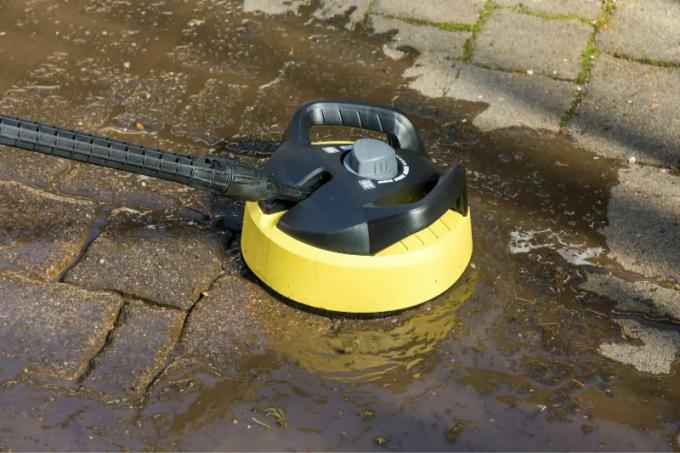
The device is also often used for cement haze that affects a larger area. In this case, the use of a surface cleaner or a rotating washing brush as an attachment is particularly useful. They do the scrubbing for you.
Instructions
- Equip the high-pressure cleaner with the brush
- Thoroughly work off concrete residue and cement residue
- finally wash off
hammer and chisel
If the high pressure cleaner is unsuitable for the stains or it is about individual residues that are quite thick, you should use a hammer and chisel. This combination of tools proves to be excellent for removing the remains, since the chisel easily gets under the cement thanks to its cutting edge. In this way, the material can be effectively removed. Once the chunks are removed, use the following steps to remove the leftovers:
- Moisten surface with water
- brush thoroughly
- rinse off
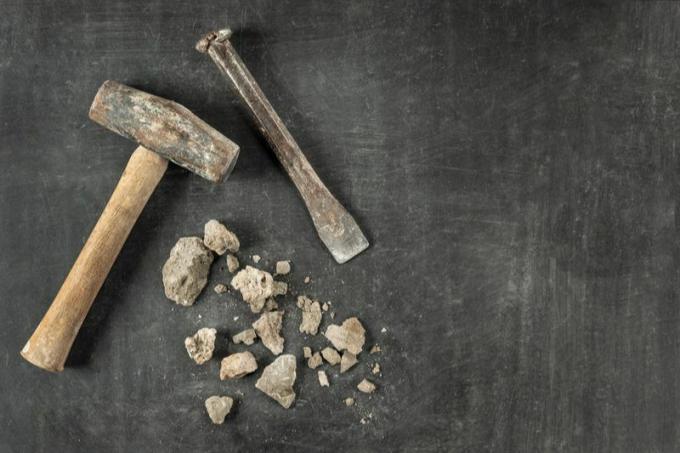
A notice: Absolutely avoid using sandpaper to remove small cement residues. Due to the nature of the surface of the paper, paving stones change their color significantly, since the surface is covered with the finest scratches.
Cement Haze Special Remover
A cement film can be very stubborn and cannot always be removed, even with powerful equipment. For this case, there are special cement residue removers that are designed exactly for this purpose. They are offered for different materials, which should be considered when purchasing. The procedure for most manufacturers is as follows.
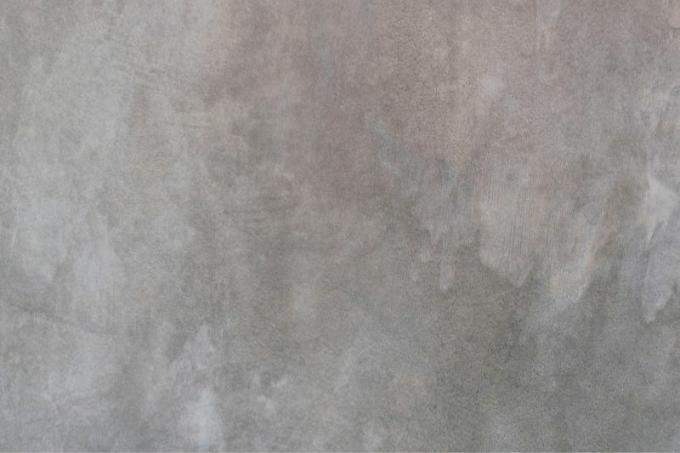
Instructions
- Mix special cleaner with water
- Mixing ratio is specified by the manufacturer
- mix well
- apply to cement residues
- Distribute with a wiper as needed
- then treat with a brush or scrubber
- Wait for the exposure time specified by the manufacturer
- scrub again
- rinse off
- repeat if necessary
Vinegar
Yes, you can use vinegar to remove cement residue from the plaster. This is only possible if the paving stones are granite, as these are acid-resistant up to a certain point. For this reason, you must ensure that the mixing ratio is correct. White vinegar is particularly suitable for this home remedy, especially apple or wine vinegar. You should not use vinegar essence because of the higher concentration.

mixing ratio
- 50 ml vinegar
- 1 liter of water
The application is very simple:
- boil water
- add vinegar
- mix well
- apply to the affected area
- Leave on for 5 to 10 minutes
- Rinse carefully with clear water
- then remove the mixture with a sponge or cloth
washing soda
If you have a concrete pavement, you can use washing soda. The carbon dioxide it contains is not suitable for natural stone, but can be used effectively to remove cement stains from concrete paving stones. As with a vinegar-based cleaner, the composition of this household remedy is of course important. So always pay attention to the correct mixing ratio to avoid damage.
mixing ratio
- 1 g powdered washing soda
- 1 liter of water
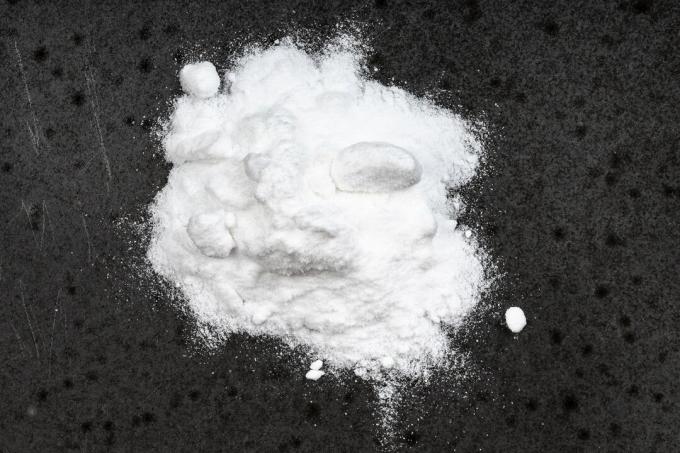
The amount of water ensures that the concrete blocks are not attacked by the acid, as it is a highly diluted cleaning agent. The individual application steps are explained in the following instructions.
Instructions
- boil water
- Stir in washing soda
- pour into containers such as watering cans
- Pour mixture directly onto cement residue
- distribute thoroughly with a broom
- 5 to 6 hours exposure time
- wash off
- use clear water for this
- finally let it dry
- Repeat application as needed
rock oil
Another way to remove cement and concrete residue from paving is to use rock oil. This product is usually a mixture based on linseed oil and other ingredients that penetrate into natural stones and at the same time work against cement. For this reason, the use of stone oil is ideal for small stains or a thin veil of cement. Stone oil is available for various types of natural stone and concrete. You have to reckon with a price of ten to twenty euros per liter.
The application as follows
- Clean pavement
- turning away is enough
- Put oil on stains or cement residue
- follow the manufacturer's instructions
- Rub in the oil with a brush
- Cement is removed at the same time
- allow to dry according to the manufacturer's instructions
A notice: If you want to remove cement from the pavement, you should choose a sunny or overcast day. Rain and other precipitation complicates cleaning and often washes away the agents used.
frequently asked Questions
To prevent stains during use, you should cover the area extensively with foil. This will prevent the patch from coming into contact with the fabric. If instead it is a possible cement residue after grouting, rub the entire paved surface with a damp brush. Just be careful not to wash out the grout.
Yes. Wear rubber gloves as a precaution to keep cement residue from getting on your skin. Cement is often irritating when it comes into contact with skin as it is a building material with a pH of 12-13 after mixing with water. It is also advisable to use protective goggles in case something goes wrong.
The waste, regardless of whether it is individual pieces of solid concrete or concrete water, may only be disposed of via the recycling center or a rubble container. Depending on the quantity, the leftovers are often taken free of charge. Be sure to find out what disposal options are available in your region.
